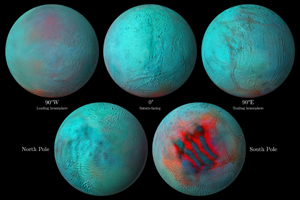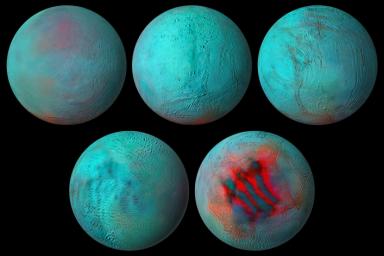
Figure 1, Annotated Image
Click on the image for larger versionClick here for movie
New composite images made from NASA's Cassini spacecraft data are the most detailed global infrared views ever produced of Saturn's moon Enceladus. And data used to build those images provides strong evidence that the northern hemisphere of the moon has been resurfaced with ice from its interior.
During Cassini's 13-year exploration of the Saturn system, the spacecraft's Visible and Infrared Mapping Spectrometer (VIMS) collected light — both visible to the human eye and infrared light — reflected off the planet, its rings, and its 10 major icy moons. VIMS then separated light into its various wavelengths, information that tells scientists more about the makeup of the material reflecting it.
Combined with detailed images captured by Cassini's Imaging Science Subsystem, the VIMS data was used to make the new global spectral map of Enceladus. It shows that infrared signals correlate with the geologic activity known to be ongoing at the south pole, where plumes of ice grains and vapor shoot out from an ocean that lies under the icy crust. The so-called "tiger stripe" gashes, where the plumes originate, are seen here.
But some of the same infrared features are also seen in the northern hemisphere. That tells scientists not just that the northern area is covered with fresh ice but that the same kind of geologic activity, a resurfacing of the landscape, has occurred in both hemispheres. The resurfacing in the north may be due to icy jets, or a more gradual movement of ice through fractures in the crust, from the subsurface ocean to the surface.
Figure 1 shows an annotated version of the globes layout, labeling each side of Enceladus in 2-D.
"Click here for movie" links to an animation made from the Enceladus infrared images.
Managed by NASA's Jet Propulsion Laboratory in Southern California, the Cassini orbiter observed Saturn for more than 13 years before exhausting its fuel supply. The mission plunged it into the planet's atmosphere in September 2017, in part to protect Enceladus: With an ocean likely heated and churned by hydrothermal vents like those on Earth's ocean floors, the moon, has the potential of holding conditions suitable for life.
The Cassini-Huygens mission is a cooperative project of NASA, ESA (the European Space Agency), and the Italian Space Agency. JPL, a division of Caltech in Pasadena, manages the mission for NASA's Science Mission Directorate in Washington. JPL designed, developed, and assembled the Cassini orbiter.
More information about Cassini can be found here: https://solarsystem.nasa.gov/cassini.

 Planetary Data System
Planetary Data System













